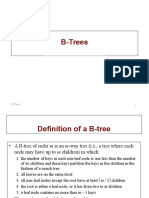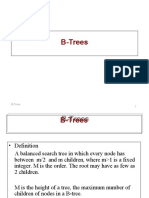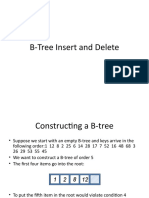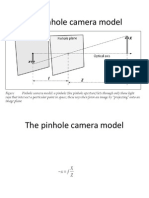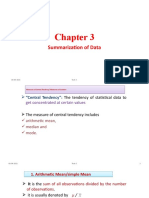B-Trees Binomial Heap Fibonacci Heap
B-Trees
Motivation for B-Trees
Index structures for large datasets cannot be stored in main memory. Storing it on disk requires different approach to efficiency. Assuming that a disk spins at 3600 RPM, one revolution occurs in 1/60 of a second, or 16.7ms. Crudely speaking, one disk access takes about the same time as 200,000 instructions.
Motivation (cont.)
Assume that we use an AVL tree to store about 20 million records. We end up with a very deep binary tree with lots of different disk accesses; log2 20,000,000 is about 24, so this takes about 0.2 seconds. We know we cant improve on the log n lower bound on search for a binary tree. But, the solution is to use more branches and thus reduce the height of the tree!
As branching increases, depth decreases
Definition of a B-tree
A B-tree of order m is an m-way tree (i.e., a tree where each node may have up to m children) in which:
1. the number of keys in each non-leaf node is one less than the number of its children and these keys partition the keys in the children in the fashion of a search tree. 2. all leaves are on the same level. 3. all non-leaf nodes except the root have at least m / 2 children. 4. the root is either a leaf node, or it has from 2 to m children. 5. a leaf node contains no more than m 1 keys.
The number m should always be odd
An example B-Tree
26 6 12
A B-tree of order 5 containing 26 items
42
1 2 4 7 8 13 15 18 25
51
62
27
29
45
46
48
53
55
60
64
70
90
Note that all the leaves are at the same level
Inserting into a B-Tree
Attempt to insert the new key into a leaf:
If this would result in that leaf becoming too big, split the leaf into two, promoting the middle key to the leafs parent. If this would result in the parent becoming too big, split the parent into two, promoting the middle key. This strategy might have to be repeated all the way to the top. If necessary, the root is split in two and the middle key is promoted to a new root, making the tree one level higher.
Constructing a B-tree
Suppose we start with an empty B-tree and keys arrive in the following order:1 12 8 2 25 5 14 28 17 7 52 16 48 68 3 26 29 53 55 45 We want to construct a B-tree of order 5 The first four items go into the root:
1 2 8 12
To put the fifth item in the root would violate condition 5 Therefore, when 25 arrives, pick the middle key to make a new root
Constructing a B-tree (contd.)
8
12
25
6, 14, 28 get added to the leaf nodes:
8
12
14
25
28
Constructing a B-tree (contd.)
Adding 17 to the right leaf node would over-fill it, so we take the middle key, promote it (to the root) and split the leaf
8 17
12
14
25
28
7, 52, 16, 48 get added to the leaf nodes
8 17
12
14
16
25
28
48
52
Constructing a B-tree (contd.)
Adding 68 causes us to split the right most leaf, promoting 48 to the root, and adding 3 causes us to split the left most leaf, promoting 3 to the root; 26, 29, 53, 55 then go into the leaves
3 8 17 48
12
14
16
25
26
28
29
52
53
55
68
Adding 45 causes a split of
25
26
28
29
and promoting 28 to the root then causes the root to split
Constructing a B-tree (contd.)
17
28
48
12
14
16
25
26
29
45
52
53
55
68
Exercise in Inserting a B-Tree
Insert the following keys to a 5-way B-tree: 3, 7, 9, 23, 45, 1, 5, 14, 25, 24, 13, 11, 8, 19, 4, 31, 35, 56
Removal from a B-tree
During insertion, the key always goes into a leaf. For deletion we wish to remove from a leaf. There are three possible ways we can do this: Case 1: - If the key is already in a leaf node, and removing it doesnt cause that leaf node to have too few keys(m / 2 -1), then simply remove the key to be deleted. Case 2: - If the key is not in a leaf then it is guaranteed (by the nature of a B-tree) that its predecessor or successor will be in a leaf -- in this case we can delete the key and promote the predecessor or successor key to the non-leaf deleted keys position.
Removal from a B-tree (2)
If (1) or (2) lead to a leaf node containing less than the minimum number of keys then we have to look at the siblings immediately adjacent to the leaf in question:
Case 3: if one of them has more than the min. number of keys then we can promote one of its keys to the parent and take the parent key into our lacking leaf Case 4: if neither of them has more than the min. number of keys then the lacking leaf and one of its neighbours can be combined with their shared parent (the opposite of promoting a key) and the new leaf will have the correct number of keys; if this step leave the parent with too few keys then we repeat the process up to the root itself, if required
Type #1: Simple leaf deletion
Assuming a 5-way B-Tree, as before...
12 29 52
15 22
31 43
56 69 72
Delete 2: Since there are enough keys in the node, just delete it
Type #2: Simple non-leaf deletion
12 29 52 56
Delete 52
15 22
31 43
56 69 72
Borrow the predecessor or (in this case) successor
Type #4: Too few keys in node and its siblings
12 29 56
Join back together
15 22
31 43
69 72
Too few keys! Delete 72
Type #4: Too few keys in node and its siblings
12 29
15 22
31 43 56 69
Type #3: Enough siblings
12 29
Demote root key and promote leaf key
15 22
31 43 56 69
Delete 22
Type #3: Enough siblings
12 31
15 29
43 56 69
Exercise in Removal from a B-Tree
Given 5-way B-tree created by these data (last exercise): 3, 7, 9, 23, 45, 1, 5, 14, 25, 24, 13, 11, 8, 19, 4, 31, 35, 56 Add these further keys: 2, 6,12
Delete these keys: 4, 5, 7, 3, 14
Analysis of B-Trees
The maximum number of items in a B-tree of order m and height h:
root level 1 level 2 . . . level h m1 m(m 1) m2(m 1) mh(m 1)
So, the total number of items is (1 + m + m2 + m3 + + mh)(m 1) = [(mh+1 1)/ (m 1)] (m 1) = mh+1 1 When m = 5 and h = 2 this gives 53 1 = 124
Reasons for using B-Trees
When searching tables held on disc, the cost of each disc transfer is high but doesn't depend much on the amount of data transferred, especially if consecutive items are transferred
If we use a B-tree of order 101, say, we can transfer each node in one disc read operation A B-tree of order 101 and height 3 can hold 1014 1 items (approximately 100 million) and any item can be accessed with 3 disc reads (assuming we hold the root in memory)
If we take m = 3, we get a 2-3 tree, in which non-leaf nodes have two or three children (i.e., one or two keys)
B-Trees are always balanced (since the leaves are all at the same level), so 2-3 trees make a good type of balanced tree
Comparing Trees
Binary trees
Can become unbalanced and lose their good time complexity (big O) AVL trees are strict binary trees that overcome the balance problem Heaps remain balanced but only prioritise (not order) the keys
Multi-way trees
B-Trees can be m-way, they can have any (odd) number of children One B-Tree, the 2-3 (or 3-way) B-Tree, approximates a permanently balanced binary tree, exchanging the AVL trees balancing operations for insertion and (more complex) deletion operations
Binomial Heap
Binomial Heaps
A way to implement mergeable heaps. Useful in scheduling algorithms and graph algorithms.
Definitions: Binomial Heap
Collection of binomial trees (satisfying some properties).
Definitions: Binomial Trees
The binomial tree B(k) is an ordered tree defined recursively. order of children is important.
1 2 4 5 3
Different Trees 3
1 2
The binomial tree B(k) consists of two binomial trees B(k-1) that are linked together
Examples
B0
B1
B2
B3 depth 0 1 2 3 4 # nodes 1 4 6 4 1
B4
Another Way to Look at Bk
Bk-2 Bk-1 Bk
B2
B1
B0
Properties of Binomial Trees
Properties of binomial tree Bk it has 2k nodes. the height of the tree is k. it has exactly Cki nodes at depth i for i = 0, 1,, k Cki = n ! / (i ! (n i) !) the root has degree k.
Binomial Heaps - Definition
Binomial heap H is an ordered list of binomial trees that satisfies the following properties: Each binomial tree is heap-ordered, i.e. for each node its key is greater or equal to the key of its parent. There is at most one binomial tree in H whose root has a given degree. Binomial trees are contained in the list in the order of increasing degrees.
Binomial Heaps - Binomial Trees
B0
B1
B2
B3
Binomial Heaps - Binomial Trees
B4
Binomial Heaps - Binomial Trees
Bk-2 Bk-1 Bk
B2
B1
B0
Binomial Heaps - Example
10
12 18
1
25 11 27 8 17 14 38
6
29
Binomial Heaps - Union - Example
12 H1 25 28 33 41 7 15 H2 37 8 29 10 44
18
30 23 22 48 31 17 45 32 24 55 50
Binomial Heaps - Union - Example
12 H1H2 18 7
25
3
37
15
28 33 41 8
6
29 10 44
30 23 22 48 31 17 45 32 24 55 50
Binomial Heaps - Union - Example
H1H2
12
18
7
25
3
37
15
28 33 41 8
6
29 10 44
30 23 22 48 31 17 45 32 24 55 50
Binomial Heaps - Union - Example
H1H2
12
18 7 25
3
37
15
28 33 41 8
6
29 10 44
30 23 22 48 31 17 45 32 24 55 50
Binomial Heaps - Union - Example
H1H2
12
18 15 28 33 41 7 25
3
37 8
6
29 10 44
30 23 22 48 31 17 45 32 24 55 50
Analogy
head[H1]
12 7 25 15 28 41 33
head[H2]
18
3 37
8
22 48 50
29 31
10
44
30
32
23 24
17
45
Union
55
Like binary addition:
prev-x head[H]
12 18 3 37 8 22 48 50 29
x
6
1 1 1(carries) 00111 10011 11010 temporarily have three trees of this degree
15 33
7 25
10
44
28 41
30 32
23 24
31
17
45 55
Binomial Heaps - ExtractMin Example
12 18 15 28 33 8 6 29 10 44
41
30 23 22 48 31 17
45 32 24 55 50
Binomial Heaps - ExtractMin Example
12 18 15 28 33 8 6 29 10 44
41
30 23 22 48 31 17
45 32 24 55 50
Binomial Heaps - ExtractMin Example
12 18 15 28 33 44 10 17 29 48 31 8 30 23 22
41
50
45 32 24
55
Binomial Heaps - ExtractMin Example
44 12 18 10 17 15 28 33 29 48 31 8 30 23 22
41
50
45 32 24
55
Binomial Heaps - ExtractMin Example
44 12 10 17 15 28 33 29 48 31 8 30 23 22
18
41
50
45 32 24
55
Binomial Heaps - ExtractMin Example
44 12 10 17 29 15 28 33 8 30 23 22
18
48 31
50
41
45 32 24
55
Binomial Heaps - ExtractMin Example
44 12 10 17 15 8 30 23 22
18
29
48 31 50
28 33
41
45 32 24
55
Binomial Heaps - DecreaseKey Example
44 12 10 17 15 8 30 23 22
18
29
48 31 10 50
28 33
41
45 32 24
55
Binomial Heaps - DecreaseKey Example
44 12 10 17 15 8 30 23 22
18
29
48 31 10
28 33
41
45 32 24
55
Binomial Heaps - DecreaseKey Example
44 12 10 17 15 8 30 23 22
18
29
10 31 48
28 33
41
45 32 24
55
Binomial Heaps - DecreaseKey Example
44 12 10 17 15 8 30 23 22
18
10
29 31 48
28 33
41
45 32 24
55
Binomial Heaps - DecreaseKey Example
44 12 10 17 10 8 30 23 22
18
15
29 31 48
28 33
41
45 32 24
55
Binomial Heaps - Summary
Binomial Heaps Heaps
Min ExtractMin DecreaseKey Union Insert Delete MakeEmpty IsEmpty
(log n) or (1) (1) (log n) (log n) (log n) (log n)
(log n) (log n)
(log n) (1) (1)
(n) (log n)
(log n) (1) (1)























